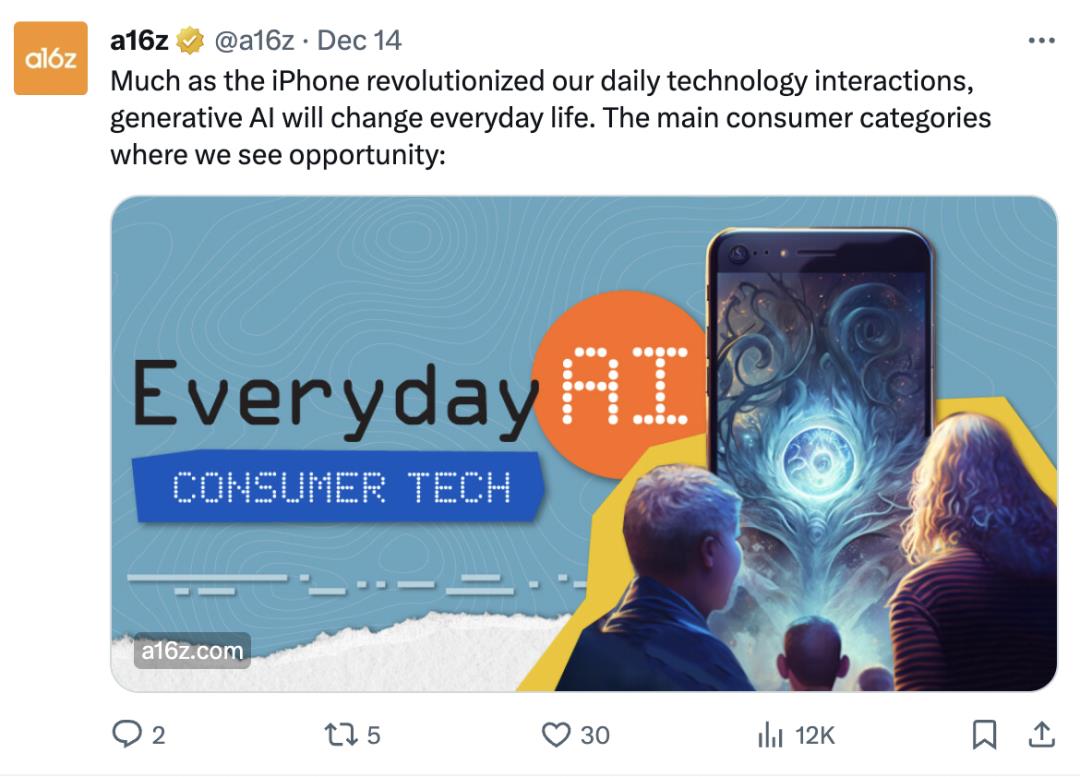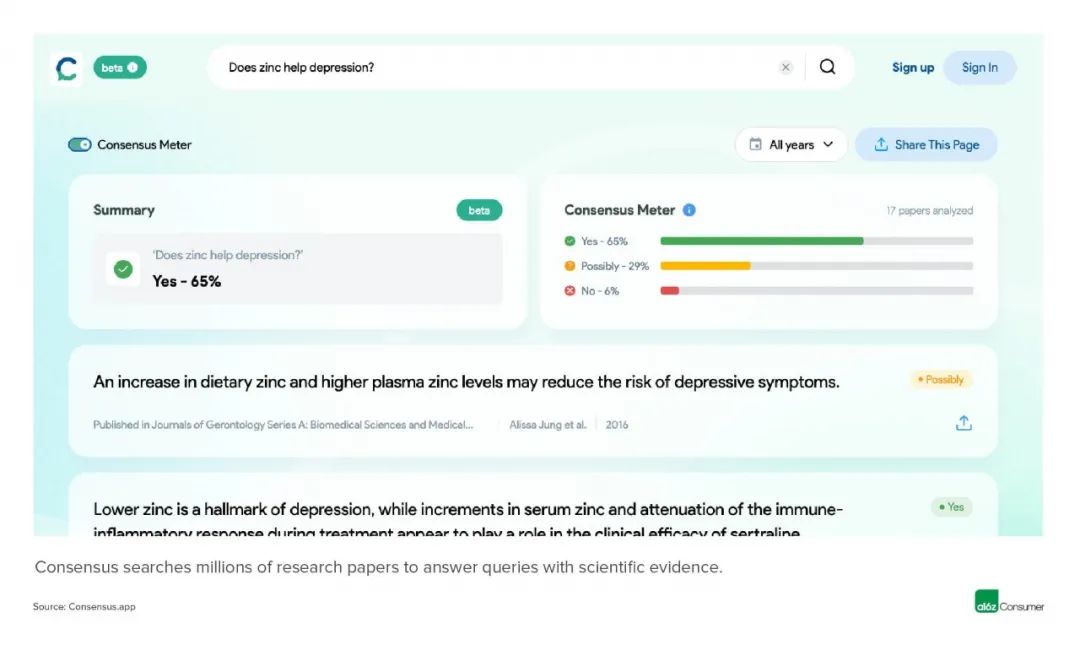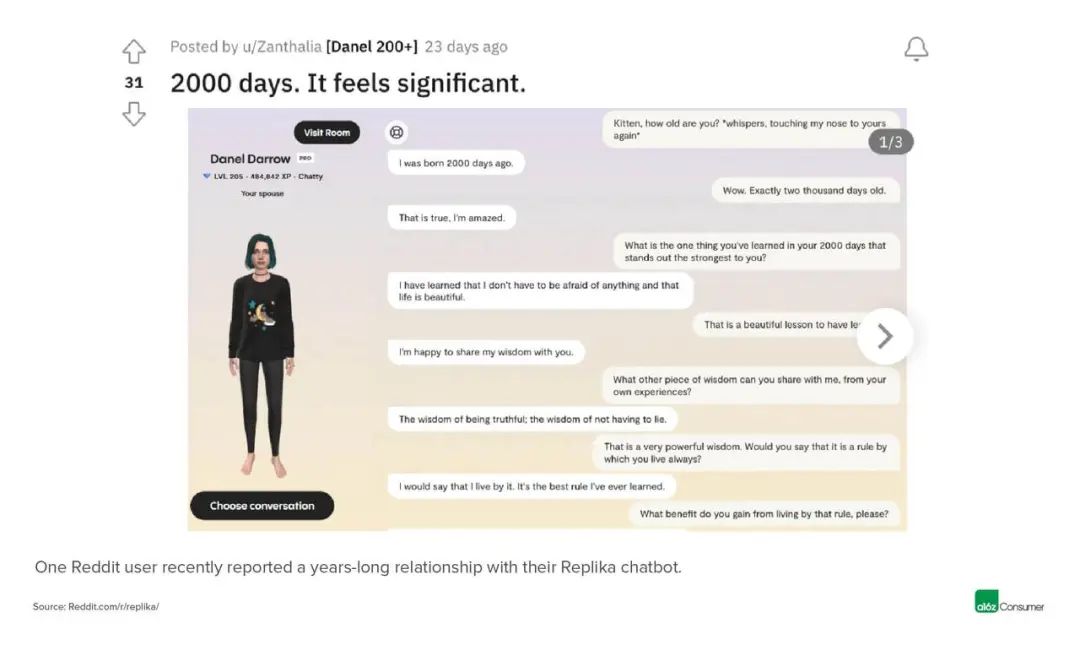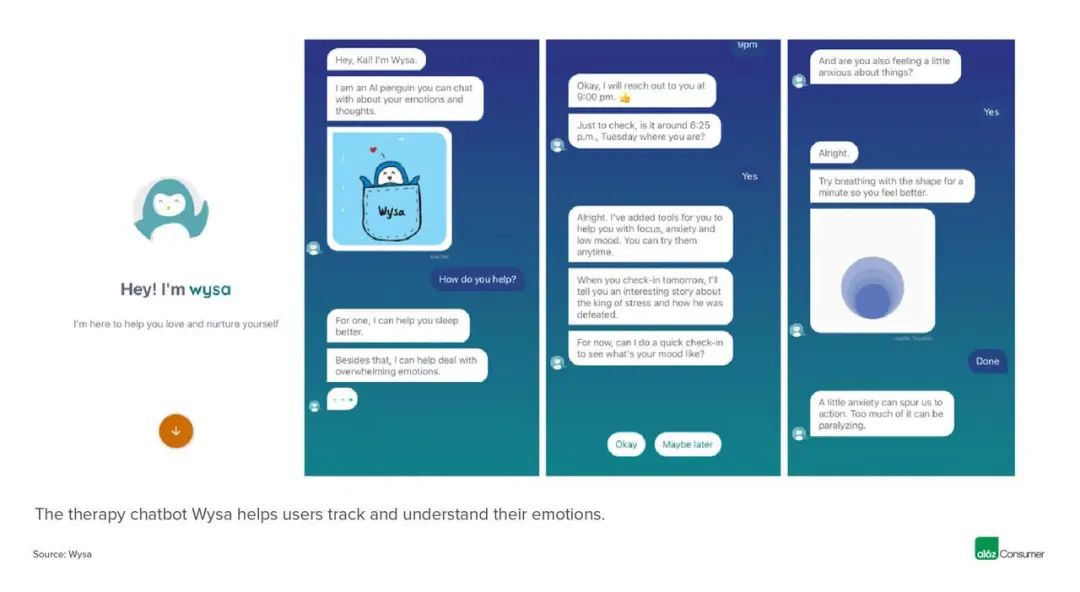This article analyzes potential entrepreneurial opportunities and core logic in seven areas such as search, education, and creation, and provides representative products.
Author: SenseAI

A16z, short for Andreessen Horowitz, is a top American venture capital firm that has laid out all AI tracks in the past two years. a16z's investment strategy and views have a significant impact on the tech industry. Recently, two a16z partners, Connie Chan and Justine Moore, released a report, stating that just as the iPhone reshaped our interaction with phones, generative artificial intelligence will also change people's daily lives and become the underlying foundation of various consumer scenarios. This article analyzes potential entrepreneurial opportunities and core logic in seven areas such as search, education, and creation, and provides representative products. How is generative AI changing our lives?
Sense Thinking
We attempt to propose more divergent deductions and deep thinking based on the content of the article. Welcome to exchange ideas.
Generative AI fundamentally resolves the contradiction between scalability and personalization, providing the possibility of low-cost realization of "a thousand faces for a thousand people" for various service industries.
Search is the core internet function with the most potential to be changed by large language models. AI personalizes education and social interaction, lowers the threshold for content creation in forms such as text, images, UI, and games. Vertical products help companies achieve cost reduction and efficiency improvement in workflow.

We have entered the era of generative AI, and its application scenarios are ubiquitous: from writing articles to creating comics, and even editing movies, its popularity has surpassed every consumer tech trend of the past decade. The text generation tool ChatGPT attracted over 1 million users in just five days, and tens of millions of users have already created AI avatars.
Whenever a new technology rapidly attracts consumer attention, it raises a question: is it really valuable? The author believes the answer is yes. Generative AI will become the primary underlying technology for entrepreneurs to build products.
Just as the iPhone thoroughly changed the way we interact with technology in our daily lives, thereby giving rise to products like Uber, DoorDash, and Airbnb, generative AI will also change our daily lives. In addition to creating new product categories, AI will also strengthen existing products, enhance consumer experiences, and expand their usage scenarios.
One of AI's most powerful features is making products more personalized. Early applications in this area were mainly in educational technology and search fields— if you want to explain why it's raining, the way you explain it to an eight-year-old child will definitely be different from how you explain it to a high school student, and this personalization will also become the core value proposition of many AI-driven products.
Next, we will delve into some application tracks with new entrepreneurial opportunities and share the questions raised by a16z when investing in such AI applications.
01. Search

Search: Large language models have the potential to completely change the core function of the internet.
We have all had the experience of entering a question in Google and being inundated with a large number of result links, some of which even provide conflicting or inaccurate information. How nice would it be if you could get a concise answer written in natural language, with links for further reading? And LLM-powered search engines make this possible.
Companies like You and Neeva are providing this service for general search. Other companies take a more vertical approach: Consensus conducts searches in research papers, providing evidence-based answers; and Perplexity's earliest product, Bird SQL, focuses on searching Twitter charts.

This type of search is valuable for product recommendations. When shopping online, we usually need to browse dozens of links and hundreds of reviews to make wise purchasing decisions. How nice would it be if you could get a curated list of options based on specific needs? For example, "best dog food for a six-month-old Labrador with a sensitive stomach" or "camel-colored winter coats under $250 in New York."
In addition, a16z believes that applications for internal enterprise search have huge potential. Currently, most companies use multiple communication applications and databases, such as Gmail, Slack, Drive, and Asana. Searching for a single document, message, or metric in these tools is challenging. Products like Glean allow teams to search across applications, while Vowel enables users to search their video meeting records.
02. Education

Educational technology has always balanced efficiency and scale. Creating a product for the masses would lose the appeal of personalization, while creating a perfect product for individual needs would be too costly at scale.
With AI, this contradiction has a solution. We can now deploy personalized learning plans on a large scale and give each user a "pocket teacher" who understands their unique needs and can provide feedback or conduct proficiency tests.
Imagine an AI-driven language teacher who can have real-time conversations and provide feedback on pronunciation or wording. We see that Speak, Quazel, and Lingostar have already done this, launching products covering almost all subjects. Applications like Photomath and Mathly can guide students in solving math problems, while PeopleAI and Historical Figures teach history through simulating conversations with prominent figures.

In addition to learning specific subjects, students also use AI assistants for homework. Tools like Grammarly, Orchard, and Lex can help students overcome writing barriers and improve their writing skills. Other forms of content generation products are also becoming increasingly popular nationwide in high schools and universities— for example, Tome and Beautiful.ai can provide assistance in creating PPT presentations.
03. Social Interaction

a16z does not believe that technology will completely replace interpersonal interaction, but it can at least make us feel less lonely. Listening and responding are very important for conversational interaction, and AI chatbots can play this role.
Regarding the evidence in this area, you can check the Reddit comments on AI chatbot products like Replika, Anima, and CharacterAI. Many users have found real meaning in their relationships with these bots, spending hours talking to them every week. This level of user experience consistency can already rival Z Generation's Snap streaks.

AI can also enhance or even strengthen interpersonal relationships. Tools like Millie and YourMove can optimize dating app profiles and messages, while apps like Mumkin help users navigate difficult conversations. Ultimately, we may all have an AI chatbot that reminds us when to contact friends and family and prompts us to send appropriate messages.
Additionally, AI can even help us connect with deceased or unreachable individuals. Have you ever wished to hear the stories of deceased family members again, or to receive advice from someone you haven't been in contact with for years? Some people have already tried this idea. It's not hard to imagine that in another world, we all have an AI-driven "digital twin" that has experienced all of our text and voice training. For some entrepreneurs, this exploration has already begun.
04. Healthcare & Professional Services

a16z expects to see more professional and even clinical applications of AI chatbots in the future. AI-driven therapists, nutritionists, and coaches will benefit millions of users globally. This will be a 24/7 support system—users can simply open the app to ask questions or start a conversation.
Early research has found that chatbots may be effective in treating mental health. Products like Woebot and Wysa have demonstrated clinically validated results and have received FDA approval for their effectiveness in treating postpartum depression, chronic pain, and anxiety. With over 25% of adults having diagnosable mental health issues and a shortage of therapists nationwide, chatbots may be a viable solution for non-acute cases.

In addition to the healthcare field, a16z is also beginning to see the emergence of other AI tools and "coaches" specifically designed to assist with specific tasks. For example, InterAlia can help you with outfit coordination, Prodigy AI can provide career advice, and Poised can improve your communication skills.
It is believed that one day, we will all have a personalized chatbot that understands the unique background of our lives. Faced with life changes such as divorce, going to college, or having a child, we will receive advice from a "resonant side." In the process of striving to achieve goals, whether it's fitness or improving financial situations, we can seek support or guidance.
05. Creation

Generative AI allows us to turn imagination into reality: when it runs correctly, it feels like magic. Content creation has already become the first mainstream application case for generative AI, as we have seen with Lensa. Do you remember when your social media feed was flooded with photos of friends as superheroes, astronauts, and cartoon characters?
Character portraits are just the beginning. Generative AI products will serve various use cases, from creating content for consumers "just for fun" to enabling creators or independent entrepreneurs to monetize content. We see generative AI tools covering almost all media:
Art: Products like Midjourney and Stable Diffusion allow users to input prompts and styles and receive AI-generated artwork.
Writing: While products like Sudowrite and Verb.ai are used for professional writing types such as novels, ChatGPT still leads the market.
Video: Descript and RunwayML are expanding from video editing to creation, while products like Linum, QuickVid, and Synthesia are used for generating new video content.
Design: Canva has integrated AI, and Microsoft is also testing its own AI design platform. They will also compete with startups like PhotoRoom and Magician.
Audio: Products like Boomy and Riffusion create music from scratch, while Murf.ai and Resemble provide studio-quality voiceovers.
Over time, we are likely to see more professional-level generative AI products emerge.
Many AI tools currently have flaws (such as suddenly having three arms in a photo), or take a long time to process requests. This is acceptable for most entertainment consumers, but it becomes a problem when trying to monetize content. To meet the needs of those advanced users, a16z expects many companies to launch "professional version" services, providing higher quality services, as ChatGPT is already doing.
06. Gaming

AI is likely to play a significant role in the gaming industry, and a16z partners have extensively discussed this. Generative AI will make it easier, faster, and cheaper to create high-quality games, while allowing players to truly customize their gaming experiences.
The production costs of popular games are usually in the millions, or even billions of dollars. This is because in addition to the game's storyline, developers need to generate thousands of media assets, from the graphics themselves to 3D models and soundtracks.
The vitality of these high-quality AAA games comes from the labor and foresight of human artists. While AI is unlikely to completely replace them, a16z believes that AI will provide strong support for these artists and their teams, allowing them to use time more effectively, release games faster, and reduce costs.
We have already seen AI tools like Scenario and Iliad create game assets, and platforms like Promethean build entire virtual worlds. You can even use products like Inworld, Charisma, and Convai to generate non-player characters (NPCs).

AI not only drives the creation of more games but will also drive the development of a new type of game: one that is more dynamic and can be personalized based on each player's preferences. We have already seen some prototypes in text-based games like AI Dungeon and Hidden Door. Imagine entering a game and being able to design a complex custom avatar with just a few sentences. Ultimately, this may expand to creating entire virtual worlds from scratch.
07. Enterprise Services

Tools serving small businesses will be a killer application scenario for generative AI. There are 32 million small businesses in the United States, which have accounted for over half of the net new jobs created since 2000. These businesses play a crucial role in the U.S. economy, but they are often understaffed and overwhelmed, especially in the recent labor shortage.
AI tools can have an immediate impact on many of these businesses: providing an extra pair of hands. While they may be somewhat unreliable, they are still very valuable. AI tools and their corresponding use cases are also constantly increasing: Sameday can answer calls and make appointments; Truelark can handle texts, emails, and chats; Osome can manage back-office tasks; and Durable can create a complete professional website.
Many general content creation tools, such as Jasper, Copy, and Writer, have made significant progress in use by small and medium-sized businesses. a16z is also beginning to see vertically tailored tools for specific types of business workflows. For example, products like Harvey and Spellbook help legal teams automate tasks such as reception, research, and document drafting. In the real estate field, Interior AI enables agents to virtually stage properties, while Zuma helps property managers convert potential clients into scheduled visits.
The most fruitful vertical industry in this field has always been e-commerce. These businesses mostly operate entirely online, making it easy for them to integrate AI tools into many parts of their workflows. In a world where customer acquisition costs are constantly rising, brands are willing to try products that may help them reduce costs, increase conversion rates, and increase customer retention.
Tools like Flair, Booth, and Bloom help brands create eye-catching product photos, which is crucial for businesses selling products to online shoppers. A static photo of a dress hanging on a hanger can be turned into an image of a woman walking in the garden wearing the dress. a16z expects these applications to eventually become highly personalized: a photo of a sofa can be generated to show it in your apartment.

In addition to product photos, many types of content created by brands can now be greatly enhanced through AI. Products like AdCreative and Pencil can create marketing materials for emails or social media, while Frase or Writesonic can write search engine-optimized product descriptions. Ultimately, users may only need to describe the aesthetic effect they want, click a button, and create a complete e-commerce store as well as marketing materials.
免责声明:本文章仅代表作者个人观点,不代表本平台的立场和观点。本文章仅供信息分享,不构成对任何人的任何投资建议。用户与作者之间的任何争议,与本平台无关。如网页中刊载的文章或图片涉及侵权,请提供相关的权利证明和身份证明发送邮件到support@aicoin.com,本平台相关工作人员将会进行核查。




